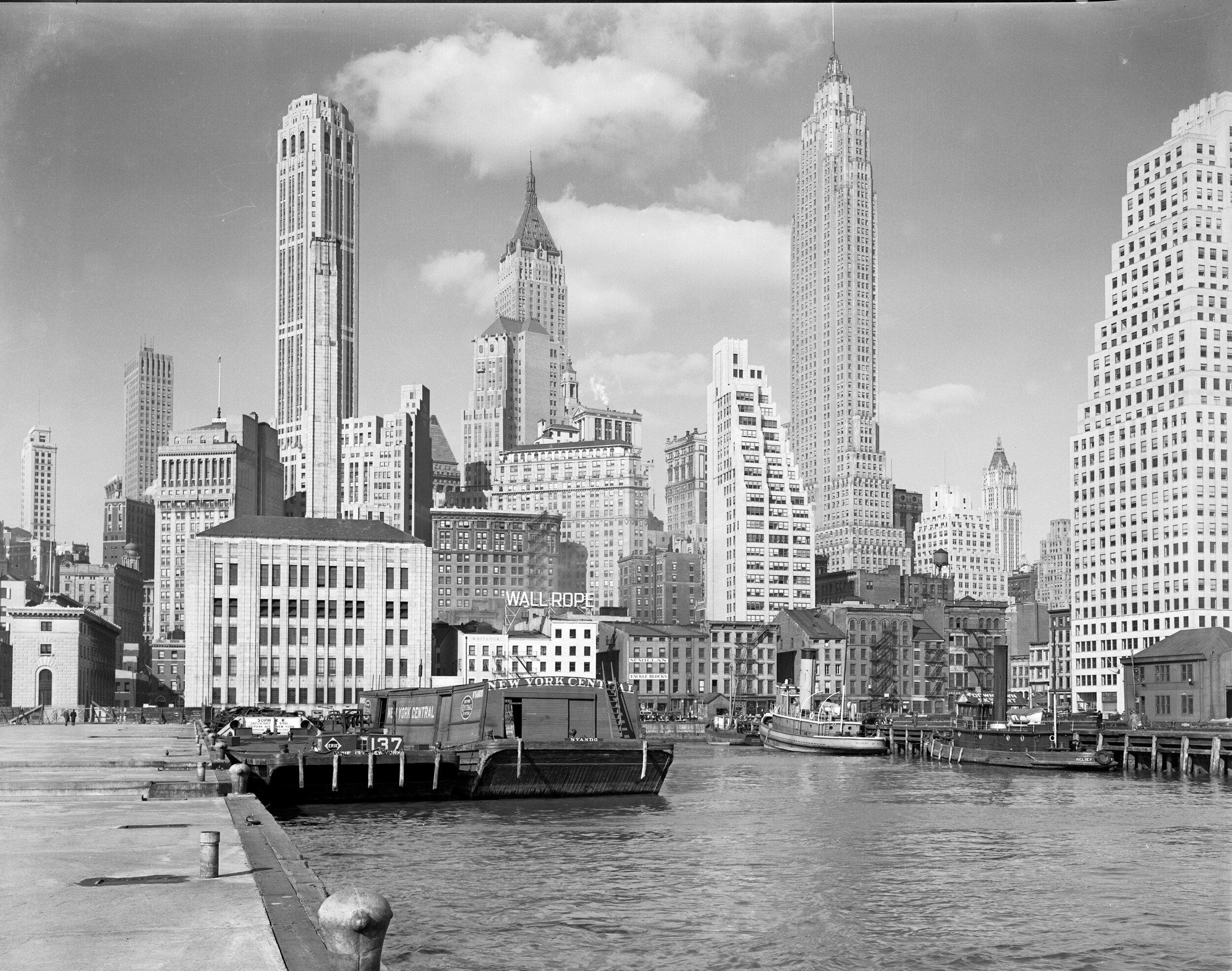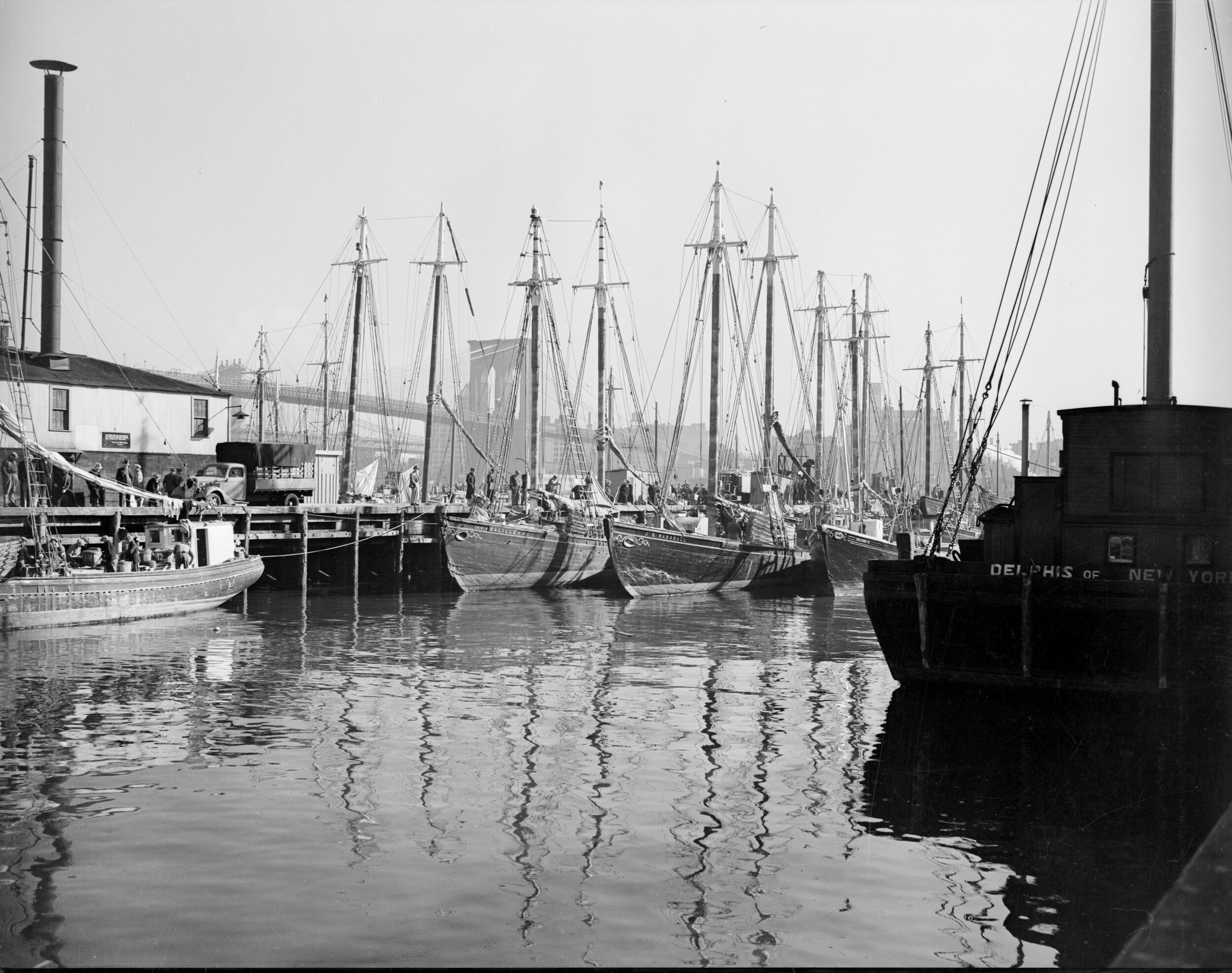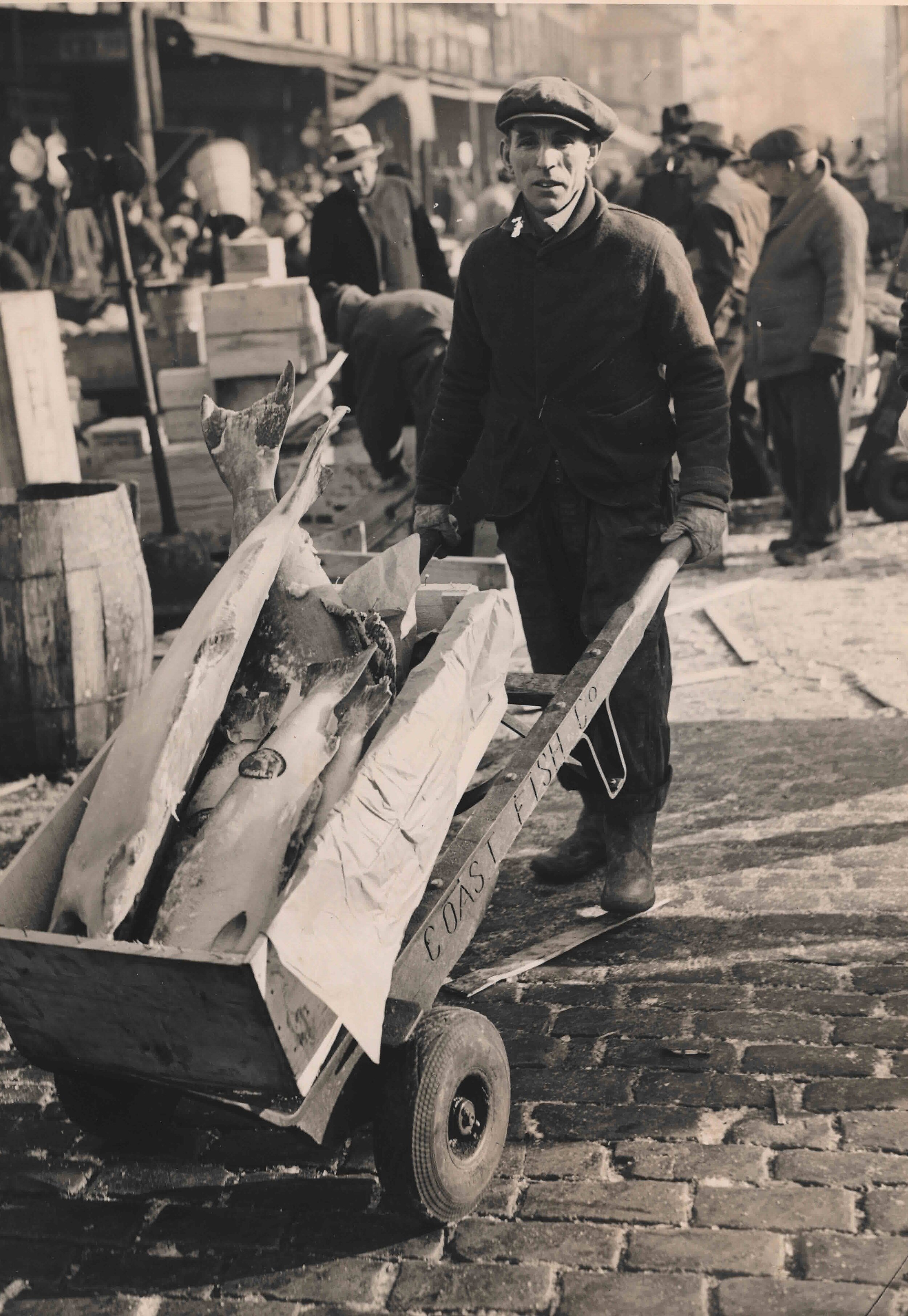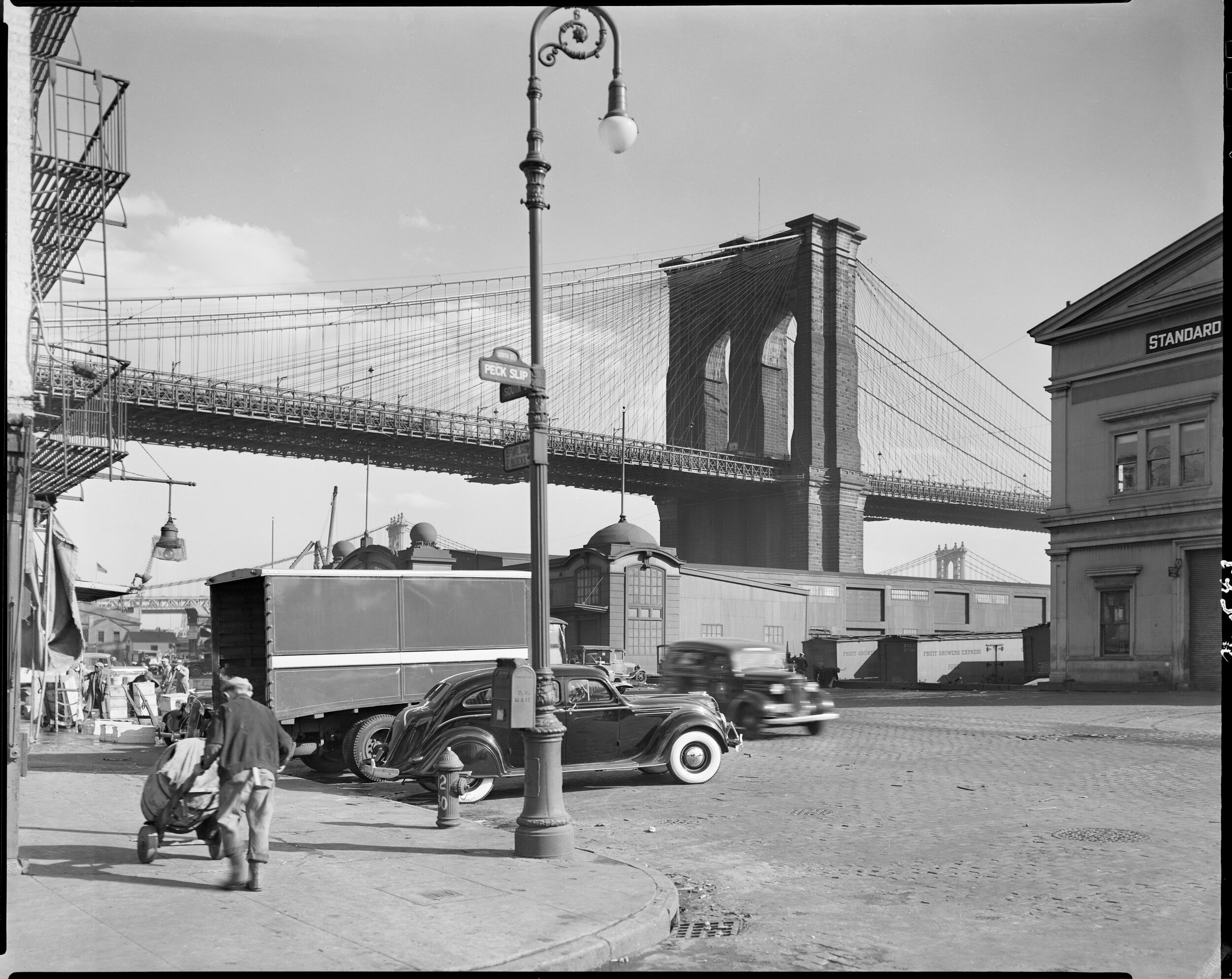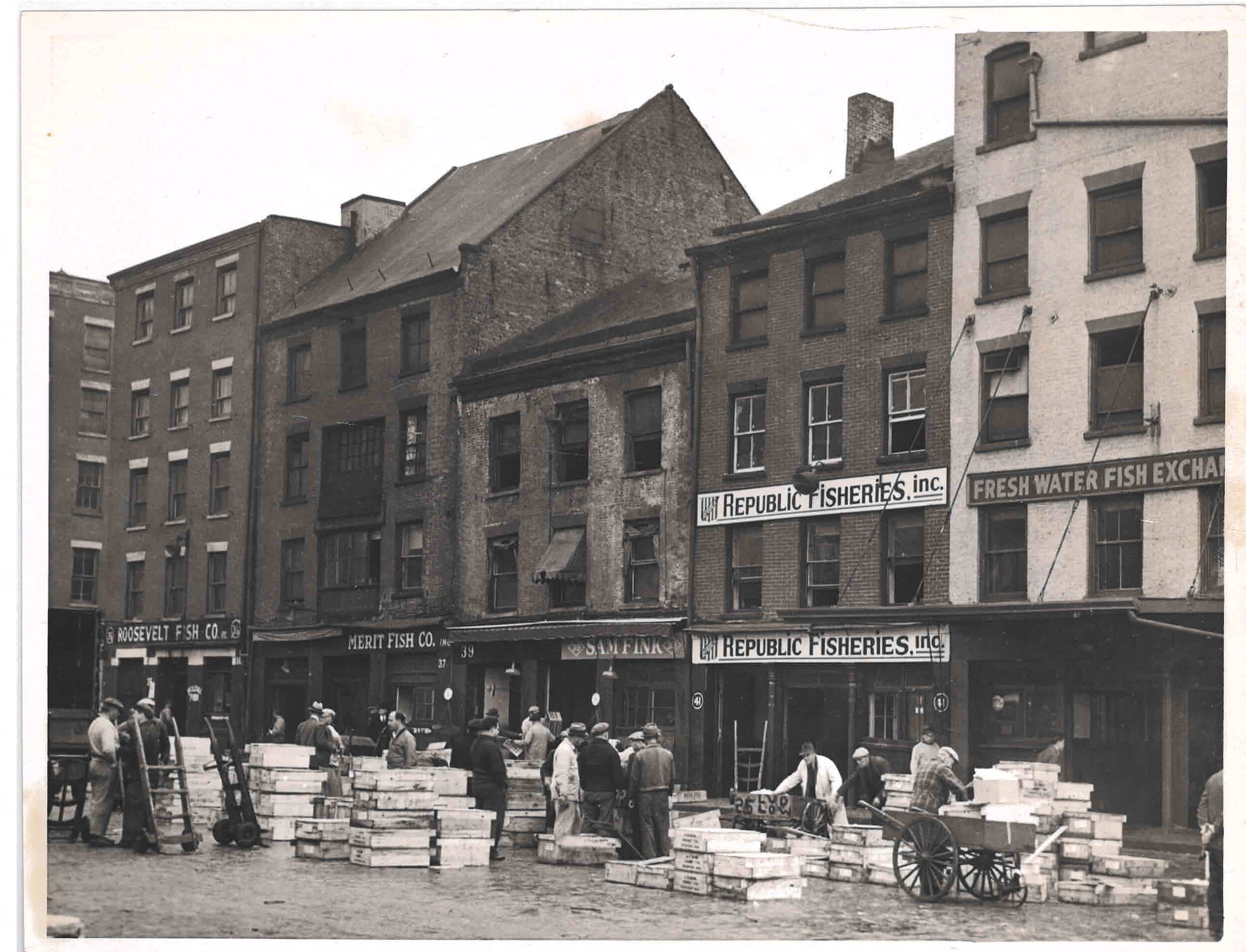This is Part 2 of a series. Read Part 1
Thomas F. De Voe in his Jefferson Market butcher stall. Frontispiece to The Market Assistant, 1867. Robert Hinshelwood, from a sketch by T.F. De Voe. Courtesy New York Public Library.
From the earliest days of the Dutch colonial settlement, butchers were at the top of the market hierarchy and their profession was tightly regulated. By the 1800s, their status was signaled by their attire, as they had taken to wearing tall top hats and tails as part of their work outfit—a look that might be familiar from the character of “Bill the Butcher” in the film Gangs of New York. In the 1850s, a well-respected Jefferson Market butcher by the name of Thomas F. De Voe, by his telling, was searching for something to do in his leisure hours. An officer of the 8th Regiment with an interest in military history, he visited the New-York Historical Society and was “bitten by a rabid antiquary.”[1] Discovering the Records and Files of the Common Council [now held by the Municipal Archives] he realized that they contained a wealth of historical information about his profession. (In actuality, he may have been conducting research to better represent himself and other butchers in regulatory matters.)
Petition of Thomas F. De Voe, Butcher, 1854. Board of Alderman, Approved Papers. NYC Municipal Archives. De Voe petitioned the Committee on Markets in 1849 and again in 1854 detailing what he saw as actions by the Superintendent of Markets that undercut the value of his stall. He later had a printed version of his 1854 petition produced but the Market Committee files include his handwritten copy and pages of his testimony before the Boards of Aldermen and Councilmen of the City.
Encouraged by the Historical Society librarian to write a paper on the subject of markets, De Voe soon entered the circle of mid-19th century historians who were preserving the history of the City, including D.T. Valentine, Clerk of the City, and E.B. O’Callaghan, who was busy translating the Dutch records of New Amsterdam. After a well-received 1858 presentation of his paper at Cooper Union, De Voe published in 1862 The Market Book: Containing a historical account of the public markets of the cities of New York, Boston, Philadelphia and Brooklyn with a brief description of every article of human food sold therein, the introduction of cattle in America, and notices of many remarkable specimens. For its time, it is a masterpiece of research. Drawing on his own experiences and using the writings of O’Callaghan and Adrian Van der Donck for Dutch history, and the records of the Common Council for colonial history, he detailed every bit of minutia on markets from the 1600s to the 1800s. The scholarly respect was mutual, as D.T. Valentine commissioned him to write a history of the “Old Fly Market Butchers” for his manual of 1868. Only volume 1 of the Market Book, on the public markets of New York, was published, but in 1866 De Voe published a paper Abattoirs and in 1867 he published The Market Assistant, containing a brief description of every article of human food sold in the public markets of the cities of New York, Boston, Philadelphia, and Brooklyn including the various domestic and wild animals, poultry, game, fish, vegetables, fruits, &c., &c. with many curious incidents and anecdotes. It included several engravings from sketches by De Voe, including a frontispiece of the man himself in his shop.
The original Fulton Market buildings, Fulton Street and Market, 1828. George Hayward for D.T. Valentine’s Manual of 1854. NYC Municipal Library.
Petition for a new market at Fulton-Slip, 1821. Common Council Papers, NYC Municipal Archives.
Petition against the removal of the Fly Market, 1821. Common Council Papers, NYC Municipal Archives.
Catharine Market, 1850. George Hayward for D.T. Valentine’s Manual for 1857. NYC Municipal Library.
De Voe’s descriptions are rich in details not just of food but in character studies. One of his most-cited passages is his description of “dancing for eels” at the Catharine Market.[2] The Catharine Market started in the late 18th Century as a humble butcher shed. Later a fishmonger’s stall was added, but in 1799 a petition was submitted for “a new and enlarged market-house.”[3] The elegant market-house was finished the following year and it became known for its Sunday eel market and as an ethnic mixing place. In the waning days of slavery in New York, enslaved African Americans from towns in Long Island, on leave for holidays such as pinkster, would sell whatever they could gather at the Catharine Market. To make a few shillings more, they would sometimes dance on a thin board or “shingle” for coins or pieces of eel at the close of the market. As these dances became a more frequent tradition, competitors from New Jersey, after dropping the farmer’s produce at the westside Bear Market would hurry over to compete. After a time, free African American residents of Manhattan came to the market to dance as well, and “if money was not to be had ‘they would dance for a bunch of eels or fish.’”[4] This tradition of “dancing for eels,” with competitive dance circles that would be familiar to the modern eye, had a long-lasting influence on dance. A popular mid-century play New York As It Is included a minstrel Dancing for Eels scene, which in turn inspired several lithographs, further cementing it in American culture. Some scholars suggest that tap dance was born here at the Catharine Market from a mix of African and Irish dance traditions. Dance steps developed here can still be seen today in modern hip-hop styles.[5]
The Ground Plan of the Fourteen Markets of the City of New-York, July 1st, 1835. Common Council Market Committee, NYC Municipal Archives. The number of markets in New York City doubled in the early 19th Century, and two new large-scale markets appeared. The Fulton Market was established in 1822 to replace the old Fly Market, but a new market building (shown here) was built in the 1830s. Washington Market in Tribeca was erected in 1813, with expansions in the 1820s and 1834 making it the largest wholesale market in the City. These markets were joined by Grand Street, Greenwich, Gouverneur, Centre, Essex, Franklin, Manhattan, Clinton, Tompkins, and Jefferson Markets. The Monroe Market would replace the Grand Street in 1836, and the Harlem Market was established in 1838, although De Voe notes a butcher shed stood at 120th Street and Third Avenue since 1807.
In 1872 Thomas De Voe gave up his butcher stall to become Superintendent of Markets under the reform-minded comptroller Andrew Haswell Green. The following year he produced a Report upon the present condition of the public markets of the city and county of New York. His report to Green would present “historical incidents as regards the age of the present market buildings; their past mode of management or mismanagement…” in his typically colorful language. He detailed the thirteen markets then active in the City: Washington, West Washington, Fulton, Centre, Clinton, Catherine, Jefferson, Tompkins, Essex, Union, Gouvernour, Franklin, and the 18th Ward Market.[6]
View of Washington Market, Fulton and Washington Street, 1859. D.T. Valentine’s Manual, 1859. NYC Municipal Library.
De Voe first addressed the largest market, the Washington, located between Greenwich, Fulton, West and Vesey streets. De Voe found the state of the market to be “generally in bad order and very much out of repair…. The two-story building on Washington Street (which had formerly sustained the fire-bell in its tower) was imminently dangerous, being in a condition at any moment to fall in and crush all beneath.” Under the floors he found that “black stagnant mud, water, animal and vegetable putrefactions had become detrimental to health and life.” The market was overseen by three “worse-than-useless officials…” who De Voe fired and replaced with “two efficient men” who were able to seize unwholesome food and suspend cheating vendors. He also installed proper sewage, drainpipes and three hydrants to better fight fires and to flush away waste.[7]
New Fish Market, New York City, ca. 1869. Theo. R. Davis, retrieved from the Library of Congress. In 1869 the Fulton Fishmonger’s Association built a new waterfront market opposite the existing Fulton Market where boats could unload their catches directly into the market.
De Voe found similar levels of disrepair and corruption throughout the markets and seems to have attacked the problems with a reformer’s zeal. Catharine Market, once charming, was long neglected and had large holes in the roof. He fixed the holes but stated whenever he looked at the “rusty fronts, roofs and side, their framed windows, doors and other woodwork, I can imagine that I can hear or feel grating on my senses the sound paint! paint!!—paint me!!!”[8] The Jefferson Market, De Voe’s former place of business, was similarly distressed, but work was already underway on the courthouse that would replace it.
Pushcart peddlers in the Lower East Side, ca. 1890. Hand-colored glass lantern slide. Department of Street Cleaning collection, NYC Municipal Archives. After the Civil War, the population of New York increased dramatically, putting enormous stress on the existing markets. As always happened, unlicensed vendors filled both a commercial need and a desire for the ethnic foods of immigrants.
More generally De Voe was concerned with the quality of food coming into the city, especially animals that had been distressed before slaughter or improperly killed. In 1866 the New York State Legislature had created the Metropolitan Board of Health. One of their first targets were outdated market regulations, particularly with regards to butchers and slaughterhouses.[9] Animal slaughtering and processing had already so polluted the Collect Pond that it was drained and filled with landfill in 1811, but the carting of offal and animal hides across town to the candle makers or tanneries was a source of increasing complaints as the more fashionable residents of the city pushed uptown. De Voe worked with the Board of Health to seize animals or meat not fit for market. The markets themselves and the surrounding unlicensed vendors also presented an enormous daily challenge to street cleaning. Numerous 19th Century laws tried to tackle the issue, such as requiring vendors to keep a trash bin at their stalls.
De Voe also called for more oversight to protect the public from “improper and unwholesome” food, better market buildings, and a reining in of unlicensed stalls and pushcarts. Pushcart vendors first appeared on Hester Street in 1866, setting up informal markets. The problem of pushcarts would only grow in the 20th century, with new waves of immigration, to the consternation of a succession of mayors.
De Voe was removed as superintendent in 1876 but reappointed in 1881. He finally retired from City service in 1883, but he continued to lecture on New York history and published a book on the genealogy of the Devaux family. When he died in 1892 the New York Times called him “one of the best known of the old New-Yorkers.”[10]
After De Voe’s retirement, the enormous open-air Gansevoort Market was officially sanctioned in 1884, and in 1889 the City built a new West Washington Market building to replace older buildings used for meat, poultry and dairy. By 1900 the area housed over 250 slaughterhouses and packing plants, earning the name the Meat Packing District.
Photograph showing a portion of the present Gansevoort and West Washington Market, ca. 1912. Brief and Plans for a New West Washington and Gansevoort Market. NYC Municipal Library. In the mid-1800s, meat and produce increasingly came into the city through freight trains and ships. In 1854 a freight depot had opened at Gansevoort and West Streets, and many vendors from the old Washington Market set up stalls near the depot.
In Brooklyn, an informal farmers market that gathered near the Navy Yard consisted of some rough sheds by 1884. The City of Brooklyn decided to grace this market with grand market halls and a prominent clock tower designed in the Dutch Colonial Revival style by William Tubby, who had just completed several buildings for the Pratt Institute. Wallabout Market, looking like a fairy-tale village, was completed in 1896, one of the last hurrahs of the independent City of Brooklyn before the consolidation of 1898. That consolidation and the increasing needs of a growing city would change the ways the City dealt with markets. However, it would be well into the 20th Century for the City to finally implement many of the market reforms that De Voe had called for.
Wallabout Market, 1896. Retrieved from the Library of Congress.
Part III coming soon.
[1] De Voe, Thomas F. The Market Book, 1862.
[2] Ibid, pp. 344-345.
[3] Ibid, p. 342
[4] Ibid, p. 344-345.
[5] Lhamon, W.T., Raising Cain: Blackface Performance from Jim Crow to Hip Hop, 2002.
[6] De Voe, Thomas F., Report upon the present condition of the public markets of the city and county of New York, 1873.
[7] Ibid, pp. 4-5
[8] Ibid, p. 15.
[9] Day, Jared N., Butchers, Tanners, and Tallow Chandlers: The Geography of Slaughtering in Early Nineteenth-Century New York City.
[10] New York Times Obituary, Thomas F. De Voe, February 2, 1892.
